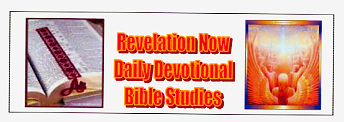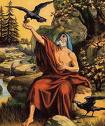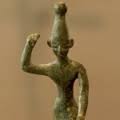
| Next | Previous | Index | Tellout Home |
41. Witnesses Prophesy
Revelation 11.1-6
"I was given a reed like a measuring rod and was told, "Go and measure God's temple and the altar, with its worshippers. But exclude the outer court. Do not measure it because it is the Gentiles'. They will trample on the holy city for 42 months. And I will appoint my two witnesses, and they will prophesy clothed in sackcloth for 1,260 days. They are the two olive trees and the two lampstands, and they stand before the earth's Lord. If anyone tries to harm them, fire comes from their mouths and devours their enemies. Anyone who wants to harm them must die this way. They have the power to shut the heavens so that it will not rain during the prophesying time, turn the waters into blood, and strike the earth with every kind of plague as often as they want." (Revelation 11.1-3) ✞
Measuring the Temple
 In his vision, John now participates in measuring the temple. The area measured out would be preserved during the coming destruction but not the outer Gentiles' Court. As he does so, John of Patmos also declares what will take place. The Greek word for "temple" here comes from the Latin word "templum," and the earlier root "tem," meaning "to cut." "Temple" comes from the idea of a space cleared or "cut down" for an altar. A temple is a "building for a god's worship" or a "consecrated section of land." In the Old and New Testaments, a temple is a place of worship and a gathering place. The word "church" is a more specific word for a Christian worship and gathering place. ✞
In his vision, John now participates in measuring the temple. The area measured out would be preserved during the coming destruction but not the outer Gentiles' Court. As he does so, John of Patmos also declares what will take place. The Greek word for "temple" here comes from the Latin word "templum," and the earlier root "tem," meaning "to cut." "Temple" comes from the idea of a space cleared or "cut down" for an altar. A temple is a "building for a god's worship" or a "consecrated section of land." In the Old and New Testaments, a temple is a place of worship and a gathering place. The word "church" is a more specific word for a Christian worship and gathering place. ✞
Two Witnesses
 "The two witnesses prophesied," for they had experienced death and resurrection. These two individuals are a potent reminder of Moses and Elijah, two of God's mighty men representing the Law and the Prophets. With God's power, Moses called plagues down upon Egypt, and Elijah defeated Baal's prophets. "Baal" was a pagan god meaning "lord" associated with the "storm and fertility god Hadad." Moses represented the Law or "Torah," and Elijah represented the Prophets. Both Elijah and Moses appeared at the Transfiguration with Christ. ✞
"The two witnesses prophesied," for they had experienced death and resurrection. These two individuals are a potent reminder of Moses and Elijah, two of God's mighty men representing the Law and the Prophets. With God's power, Moses called plagues down upon Egypt, and Elijah defeated Baal's prophets. "Baal" was a pagan god meaning "lord" associated with the "storm and fertility god Hadad." Moses represented the Law or "Torah," and Elijah represented the Prophets. Both Elijah and Moses appeared at the Transfiguration with Christ. ✞
Two Olive Trees
 The two olive trees and the two lampstands are symbolic of the Old Testament's two great heroes. In Zechariah 4.1-3, we read, "Then the angel who talked with me returned and woke me up as someone awakened from sleep. He asked me, 'What do you see?' I answered, 'I see a solid gold lampstand with a top bowl and seven lamps on it, with seven lamp channels. Also, two olive trees are by it, one on the bowl's right and the other on its left.'" An angel identified two olive trees in Zechariah 11.14, "These are the two anointed to serve the Lord of all the earth." The "two anointed ones" means "the two who bring the oil," hence the olive oil for the lamps. These two olive trees are symbolic of the two witnesses. They wear sackcloth, a coarse, rough woven material usually made from goat's hair, flax, or hemp, often symbolizing mourning. ✞
The two olive trees and the two lampstands are symbolic of the Old Testament's two great heroes. In Zechariah 4.1-3, we read, "Then the angel who talked with me returned and woke me up as someone awakened from sleep. He asked me, 'What do you see?' I answered, 'I see a solid gold lampstand with a top bowl and seven lamps on it, with seven lamp channels. Also, two olive trees are by it, one on the bowl's right and the other on its left.'" An angel identified two olive trees in Zechariah 11.14, "These are the two anointed to serve the Lord of all the earth." The "two anointed ones" means "the two who bring the oil," hence the olive oil for the lamps. These two olive trees are symbolic of the two witnesses. They wear sackcloth, a coarse, rough woven material usually made from goat's hair, flax, or hemp, often symbolizing mourning. ✞
Canterbury Murder
 Prophets sometimes wore sackcloth as a submission sign. In Christianity, wearing a sackcloth hair shirt in the Middle Ages acted as a deliberate punishment of the body. Penitents wore it on Ash Wednesday, Good Friday, and Fridays in the Lenten season. Sackcloth could be an empty sack with holes for the head and arms or otherwise a loincloth. It could be worn all the time under one's clothes as a repentance sign. "They should be wearing sackcloth and ashes in token penance for committed wrongs." The Archbishop of Canterbury, Thomas Becket, or Thomas a Becket (1119-1170 AD), was murdered in Canterbury Cathedral by four King Henry the Second (1133-1189 AD) knights. When Thomas's servants removed his ornate outer clothing to prepare his body for burial, they were astonished to find underneath a vermin-infested sackcloth hair shirt, a sign of his repentance to God! ✞
Prophets sometimes wore sackcloth as a submission sign. In Christianity, wearing a sackcloth hair shirt in the Middle Ages acted as a deliberate punishment of the body. Penitents wore it on Ash Wednesday, Good Friday, and Fridays in the Lenten season. Sackcloth could be an empty sack with holes for the head and arms or otherwise a loincloth. It could be worn all the time under one's clothes as a repentance sign. "They should be wearing sackcloth and ashes in token penance for committed wrongs." The Archbishop of Canterbury, Thomas Becket, or Thomas a Becket (1119-1170 AD), was murdered in Canterbury Cathedral by four King Henry the Second (1133-1189 AD) knights. When Thomas's servants removed his ornate outer clothing to prepare his body for burial, they were astonished to find underneath a vermin-infested sackcloth hair shirt, a sign of his repentance to God! ✞
Wearing Sackcloth
 In 1 Kings 20.31, we read that Aramean soldiers sought mercy from Israel's King, "wearing sackcloth around their waists and ropes around their heads. They went to Israel's king and said, 'Your servant Ben-Hadad says, "Please let me live."'" On another occasion, Isaiah wore nothing, not even sackcloth. In Isaiah 20.2, we read, "at that time the Lord spoke through Isaiah, son of Amoz. He said to him, 'Take off the sackcloth from your body and the sandals from your feet.' And he did so, going around stripped and barefoot. Then the Lord said, 'Just as my servant Isaiah has gone stripped and barefoot for three years, as a sign and portent against Egypt and Cush, so Assyria's king will lead the stripped barefoot Egyptian captives and both young and old Cushite exiles, with buttocks bared to Egypt's shame.'" "Egypt and Cush" describe Egypt's Upper Nile Region. ✞
In 1 Kings 20.31, we read that Aramean soldiers sought mercy from Israel's King, "wearing sackcloth around their waists and ropes around their heads. They went to Israel's king and said, 'Your servant Ben-Hadad says, "Please let me live."'" On another occasion, Isaiah wore nothing, not even sackcloth. In Isaiah 20.2, we read, "at that time the Lord spoke through Isaiah, son of Amoz. He said to him, 'Take off the sackcloth from your body and the sandals from your feet.' And he did so, going around stripped and barefoot. Then the Lord said, 'Just as my servant Isaiah has gone stripped and barefoot for three years, as a sign and portent against Egypt and Cush, so Assyria's king will lead the stripped barefoot Egyptian captives and both young and old Cushite exiles, with buttocks bared to Egypt's shame.'" "Egypt and Cush" describe Egypt's Upper Nile Region. ✞
Turning Water into Blood
 God gave both Moses and Elijah miraculous powers. Elijah closed the sky so that it did not rain. Moses turned water into blood. In Exodus 7.19, "The LORD said to Moses, 'Tell Aaron, "Take your staff and stretch out your hand over the streams and canals of Egypt's waters, over the ponds and reservoirs and they will turn to blood." Blood will be everywhere in Egypt, even in wooden and stone vessels.'" Moses used the miracles and plagues before Egypt's Pharaoh to persuade him to finally let Israel's people leave Egypt and journey to the promised land. Control over rain and turning water into blood are two characteristics given in Revelation to the two olive trees or two lampstands indicative of Moses and Elijah. ✞
God gave both Moses and Elijah miraculous powers. Elijah closed the sky so that it did not rain. Moses turned water into blood. In Exodus 7.19, "The LORD said to Moses, 'Tell Aaron, "Take your staff and stretch out your hand over the streams and canals of Egypt's waters, over the ponds and reservoirs and they will turn to blood." Blood will be everywhere in Egypt, even in wooden and stone vessels.'" Moses used the miracles and plagues before Egypt's Pharaoh to persuade him to finally let Israel's people leave Egypt and journey to the promised land. Control over rain and turning water into blood are two characteristics given in Revelation to the two olive trees or two lampstands indicative of Moses and Elijah. ✞
"Witnesses Prophesy"
by Ron Meacock © 2021
| ^Top Page | Next | Previous |